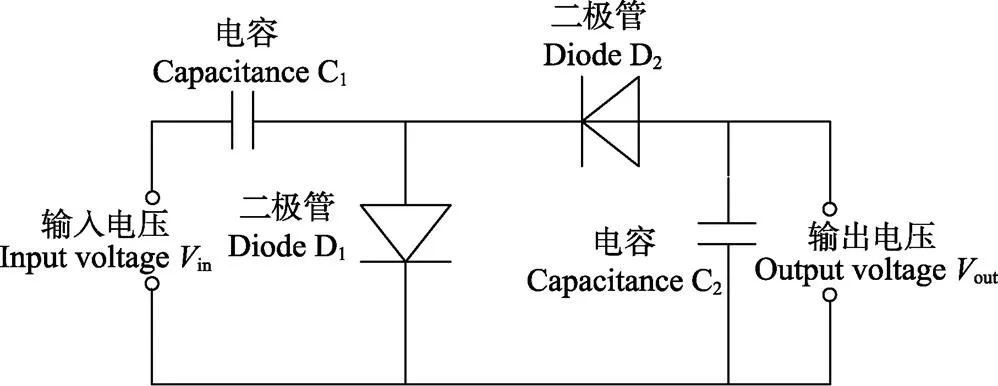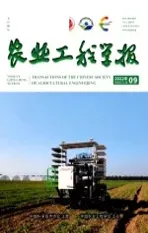传感器节点自主供电的环境混合能量收集系统设计
2017-05-25徐雷钧潘祎雯毛罕平
徐雷钧,白 雪,潘祎雯,毛罕平
传感器节点自主供电的环境混合能量收集系统设计
徐雷钧1,2,白 雪1,潘祎雯1,毛罕平3※
(1. 江苏大学电气信息工程学院,镇江 212013;2. 东南大学毫米波国家重点实验室,南京 210096;3. 江苏大学现代农业装备与技术省部共建教育部重点实验室,镇江 212013)
农田复杂环境及大面积监测需求对农业物联网传感器节点的供电提出了极大挑战,而环境能量收集技术则使低功耗农业物联网传感器节点的自供电及免维护成为可能。针对传统能量收集装置中收集的环境能量单一有限、装置体积大、可靠性差的问题,该文提出了一种新型混合环境能量一体化收集系统。该系统定位于环境中普遍而丰富的射频电磁波能量和振动能量,通过射频收集天线和压电陶瓷的有效结合,同时收集2种环境能量,并经整流转换成直流电能。能量收集天线使用普通FR4印刷电路板实现,工作在手机通信频段1.9 GHz(3G频段),测试的回波损耗为-20.5 dB,对电磁波能量收集的最高输出功率可达到38 mW,测得收集到的振动能量最大输出功率可达到25 mW,满足低功耗传感器节点的功率需求。该装置不仅可以有效提高系统供电的可靠性和对环境的适应能力,还大大降低了传统混合系统的尺寸,可为农业物联网快速发展中的传感器节点可靠供电问题提供参考。
传感器;整流电路;设计;农业物联网;能量收集;射频能量;振动能量;匹配网络
0 引 言
随着电子技术的高速发展,各种无线电子产品充斥在人们的生产生活中。在一些特殊环境中,如高辐射、高温、高空、高寒地区,不方便人类直接进行监测,可以通过安装无线传感器完成监测和实时传输[1];尤其在农业应用领域,近年来,在种植、畜牧、水产养殖、农产品加工与运输等领域[2-3],物联网技术得到了快速发展。但是农业领域中,田间环境具有其独特性,直接影响农作物的生长情况,而农作物的生长又会反作用于田间环境[4-5]。有些农田不适用于电池的铺设,电池的安装容易污染田间环境。此外,农业物联网节点还具有单个节点耗能低,规模大、持续时间长的特点[6-7]。例如获取信息与智能灌溉的传感器节点所需功耗为15 mW[8],农田温湿度信息采样时的功耗为53 mW[9]。当前研究的重点集中于物联网节点的低功耗传输,例如加入节点休眠时间,使得节点平均功耗低至10 mW以下[10-11]。随着电子技术不断发展,传感器节点的功耗还会进一步降低,一些低功耗传感器如气压传感器MS5607-B功耗仅为1.8W,温度传感器DS18B20功耗低于5 mW,数字温湿度传感器SHT1x的功耗为3 mW。鉴于上述常用传感器的功耗均不超过10 mW,本文提出从环境中收集能量供电于农业物联网节点,将“开源”与“节流”相结合[12],以此实现低功耗传感器节点的自主供电。
在当前各种无线设备普及的社会,射频(radio frequency, RF)能量存在于周围环境中的普遍性以及收集的便利性与可行性[13],使其在低功耗自供电系统中的应用具有广阔前景。近些年,基于无线能量传输理论的射频能量收集技术越来越多地应用于低功耗的电子设备,如无线传感器网络、电子医疗设备、RFID等低功耗的电子设备[14]。2012年,意大利卡塔尼亚大学研发出了一个射频收发器芯片,由射频电磁波供能,最低的输入功率为30W[15];2013年,美国华盛顿大学和弗吉尼亚大学研发出了一个身体传感器节点的芯片,由射频电磁波供能,整个芯片耗能仅为19W,能够获取、处理和传输心电图、肌电图和脑电图数据[16];美国俄勒冈州立大学在2014年发明了一款用于无线传感器供电的射频能量收集器,该射频能量收集器的最低输入功率能达到–20 dBm[17]。其中,高性能天线的研究与设计对射频能量收集系统具有重要意义[18]。
机械振动能是环境中普遍存在的一种能量形式,广泛存在于普通家庭设备(如冰箱、洗衣机、微波炉)、工业设备、交通工具、建筑物环境[19-22]以及人体活动[23]等场合。振动能可由压电材料转换为电能,具有易收集,转换效率高的特点。所以利用压电陶瓷收集振动能已成为国内外研究的重点。早期荷兰学者Elfrink等[24]测试的单个MEMS 器件在1(为重力加速度)振动加速度下,输出功率为60W。2016年,Chen等[25]对风能振动进行研究,输出最低电压所需的风速为4 m/s,当风速达到14 m/s时压电片的开路电压达到19.8 V。
传统能量收集装置大多采集单一类型的环境能量,而单一能量收集时其输出功率通常较低,还容易造成输出功率断续[26-28]。本文针对这一问题,将研究环境中普遍存在的射频电磁波能量和振动能量的联合收集技术,提出一种一体化混合能量收集系统,将射频能量收集器与振动能量收集器有效的整合为一体,共享同一整流电路,减少电路尺寸,以期为低功耗传感器提供较稳定的直流电能。
1 系统结构和原理
传统的能量收集系统仅能采集单一类型的环境能量或将多个单一能量收集器简单组合而构成,系统结构示意如图1a所示,这种结构不仅降低了系统的可靠性,而且收集装置因采用独立的电路结构使得系统的尺寸较大。本系统通过同一个整流电路实现射频能量与振动能量的转换,从而节省了电路尺寸,同时可提高系统的稳定性,降低系统损耗。本文提出一种将振动能量收集器嵌入在射频能量收集器中的一体化结构,如图1b所示。该系统中的能量接收模块对传统射频天线进行了改进,在不影响原有射频能量收集器收集能量的条件下,实现了振动能与射频能一体化收集。
混合环境能量收集系统原理如图2所示,混合能量收集模块包括2部分:射频与振动能转换模块和输出模块。系统各模块功能如图2所示。
图2中接收天线用于接收环境中相应频段的射频电磁波能量;压电片用于将振动能量转变为电能。利用压电陶瓷的正压电效应,对压电片施加机械力,引起内部的正负电荷发生相对位移而产生电的极化,从而使介质上下表面出现正负电荷,将机械能转变成电能。

图2 一体化混合能量收集系统原理图
阻抗匹配电路实现天线与后级电路输入的阻抗匹配,获得最大功率传输,此时天线收集到的射频能量会以最高效率传输至后级电路。
整流电路将交流电转变成直流电。采用2倍压整流电路,振动能量与射频电磁波能量收集共用同一个整流电路。储能电容C0将收集到的能量一部分直接输出,为负载提供电能,一部分储存在电容中。
2 一体化混合能量收集系统设计
2.1 天线设计
混合能量收集系统的一体化前端结构参数如图3所示,天线的中心频率为1.9 GHz,介质材料为FR4,介电常数ε为4.6,介质厚度为1.6 mm。

注:W0为贴片天线宽度,mm;L0为贴片天线长度,mm;W1、W2、W3为馈线不同部分的宽度,mm;D为天线阵元间距,mm。
基于天线理论,矩形贴片天线阵元长度0与宽度0的估算公式为[29]

式中0为穿过天线基板介质的电磁波波长,m;为真空中的光速,m/s;ε为基板介质材料的相对介电常数;为天线工作频率,Hz。
天线阵元间距估算公式为[30]

其中为天线阵元数。
根据以上公式估算出辐射贴片天线阵元的长度、宽度与间距后,确定了天线的主体尺寸,再通过HFSS软件进一步优化馈线宽度与修正贴片尺寸,使天线在工作频段达到最佳回波损耗,此时获得最佳输入阻抗匹配。最终得到贴片天线的宽度0为36 mm,贴片天线的长度0为37 mm,馈线宽度123分别为1.5、2、2.98 mm,天线阵元的距离为21 mm。
2.2 压电片设计
从图3混合环境能量收集装置前端结构可以看出,微型压电振动能模块放置在微带天线的右下侧,微型振动能量收集器由压电陶瓷和基板共同组成,从压电片和基板分别引出正负极。当装置振动后输出交流电压,然后进入整流电路。
压电陶瓷的振动模式有33和312种模式,如图4所示。31模式中,电压为3方向,应力为1方向,当在1方向施加外力时,垂直极化方向的电极表面会产生电荷;33模式中,电压和应力都在3方向,当在3方向施加外力时,垂直极化方向的电极表面就会产生电荷。根据压电理论可知33模式的耦合系数比31模式高[31],因此33模式能够获得更好的能量转换,本设计中,压电片选择效率更高的33振动模式。

1. 水平方向 3. 垂直方向
2.3 整流电路
射频电磁波能量与振动能量共用同一个整流电路,其中,整流二极管的特性决定了整流电路的效率。首先需要对整流二极管进行选型,而后才能设计后级电路。肖特基二极管具有导通压降低、开关频率高的优点,常常被用作微波整流,该类型二极管也适用于低频整流电路。为了提高电压,在本设计中选择2倍压整流电路,如图5所示,它由2个二极管(D1、D2)和2个电容(C1、C2)组成。与传统单个二极管构成的半波整流电路相比,在不增大版图尺寸的情况下,根据2倍压整流原理,输出电压增大了一倍,提高了转换效率。其中贴片电容C1=10 pF,C2=470F。

图5 整流电路原理图
2.4 阻抗匹配网络
由于二极管是非线性元件,从接收天线输出的高频交变电流流过二极管时,会产生高次谐波,如果对这些高次谐波不加抑制,其反射会严重干扰接收天线的性能。因此,可以在整流电路和接收天线间加入阻抗匹配网络,用于抑制高次谐波的反射。
通过对天线阻抗和整流电路输入阻抗进行共轭匹配,可以实现最大功率传输[30],使反射系数最小。在射频波段,由于分立元件内部的寄生参数对电路会产生很大影响,因此需要使用分布参数元件进行电路设计,实际测量的天线端口阻抗为(47.8+j9.0)Ω,经过匹配之后的整流电路输入阻抗应为(47.8–j9.0)Ω,此时,可以达到最高功率传输。由于整流电路实测的输入阻抗为(11–j21.16)Ω,采用L型阻抗匹配将其输入阻抗匹配至接近(47.8–j9.0)Ω。使用Agilent公司Advanced Design System(ADS)软件设计L型阻抗匹配网络,如图6所示。将整流电路的输入阻抗实测数据导入ADS中与匹配网络进行联合仿真优化,最终达到了较好的匹配效果。

图6 阻抗匹配网络
3 测试分析
3.1 天线测试分析
使用Agilent ADS和矢量网络分析仪分别对天线进行仿真与测试,矢量网络分析仪为中电41所生产,型号为AV3656B,测试的动态范围达125 dB,回波损耗测试结果如图7所示。

图7 天线的回波损耗
从图7中可以看出,矩形微带天线仿真的谐振频率为1.9 GHz,回波损耗为–17.6 dB,测试的谐振频率偏离到1.912 GHz,回波损耗为–20.5 dB,仿真和实测结果误差较小,频率偏移在1%范围内[33],中心频率偏移至1.912 GHz并不影响天线对该频段信号的接收,因此该误差是可接受的。天线的辐射增益方向仿真结果如图8所示,、、表示3个方向的坐标轴,最大增益出现在轴两侧为3.12 dB。

图8 天线辐射增益仿真结果
3.2 系统测试分析
以苹果iphone5S手机基于移动3 G网络为射频发射源,测试手机在拨号状态下,整流天线距离手机不同位置时的输出电压和LED亮暗程度。通过对输出电压的测量和LED亮度观测,获得整流天线阵列接收到的能量大小。当手机贴近天线测试时,LED高亮。当手机距离天线2 cm时,LED微亮。对不同距离时的输出电压进行测试,具体测试数据如表1所示。

表1 能量收集测试结果
表1的结果表明,整流天线到手机的距离越小,整流天线收集到的辐射能量越大。当天线与手机的距离超过5 cm时,LED不亮,LED两端电压降到大约0.1 V左右。测得贴片LED在高亮状态下的工作电流为20 mA,可以算出贴片LED最大输出功率约为38 mW,可知3G手机拨号情况下辐射功率是比较大的。
使用固纬示波器GDS3502对压电片振动能量输出电能进行实测,电压测量精度为1mV,设置示波器输入内阻为50 Ω,对能量收集系统输出功率进行试验。输出波形如图9所示,横轴为时间轴,纵轴为电压值。考虑到田间振动频率较低,在10 Hz的时候,测得电压幅值为1.11 V,输出功率为25 mW。

注:示波器输入内阻为50 Ω
4 结 论
振动能量收集装置和射频能量收集装置的研究逐渐成熟,本文在对其分别进行研究和设计的基础上,提出了一种新型一体化混合能量收集装置,此装置通过矩形贴片天线与压电片的一体化设计,共享一个整流电路,有效缩减了尺寸,提升了系统可靠性,实现了同时收集射频能和压电式振动能的紧凑系统结构,测试表明该能量收集系统在手机1.9 GHz频段发射状态下获得的最大输出功率为38 mW;在10 Hz振动条件下,获得的输出功率达到25 mW。
该装置适用于电磁波能量集中的地方,或有水流、风力集中的地方,如手机基站附近的农田或灌溉种植农业等场合,电磁波能量与振动能互为补充。试验证明,该装置可用于农业物联网传感器节点自主供电。
该能量收集技术不但保障系统可靠持续供电,还能免除废弃电池对环境的污染,对推动环境保护,节能低碳具有积极作用和深远的意义。可进一步推广应用于生物医疗电子、智能家居、汽车电子等领域。
[1] 江发昌. 无线充电传感器网络系统及应用[D]. 杭州:浙江大学,2012. Jiang Fachang. The System and Applications of Wireless Rechargeable Sensor Networks[D]. Hangzhou: Zhejiang University, 2012. (in Chinese with English abstract)
[2] 阎晓军,王维瑞,梁建平.北京市设施农业物联网应用模式构建[J]. 农业工程学报,2012, 28(4):149-154. Yan Xiaojun, Wang Weirui, Liang Jianping. Application mode construction of internet of things(IOT) for facility agriculture in Beijing[J]. Transactions of the Chinese Society of Agricultural Enineering (Transactions of the CSAE), 2012, 28(4): 149-154. (in Chinese with English abstract)
[3] 葛文杰,赵春江. 农业物联网研究与应用现状及发展对策研究[J]. 农业机械学报,2014,45(7):222-230. Ge wenjie, Zhao Chunjiang. State-of-the-art and developing strategies of agricultural internet of things[J]. Transactions of the Chinese Society for agricultural machinery, 2014, 45(7): 222-230. (in Chinese with English abstract)
[4] 张军,张侃谕. 温室温度控制系统不确定性与干扰的灰色预测补偿算法[J]. 农业工程学报,2013,29(10):225-233. Zhang Jun, Zhang Kanyu. Grey prediction compensation algorithm for the uncertainty and interference of greenhouse temperature control system[J]. Transactions of the Chinese Society of Agricultural Engineering (Transactions of the CSAE), 2013, 29(10): 225-233. (in Chinese with English abstract)
[5] Rafal P, Tomasz S, Magdalena B W. The suitability of an unmanned aerial vehicle (UAV) for the evaluation of experimental fields and crops[J]. Agriculture, 2012, 99(4): 431-436.
[6] 杜克明,褚金翔,孙忠富,等. WebGIS在农业环境物联网检测系统中的设计与实现[J]. 农业工程学报,2016,32(4):171-178. Du Keming, Chu Jinxiang, Sun Zhongfu, et al. Design and implementation of monitoring system for agricultural environment based on WebGIS with Internet of Things[J]. Transactions of the Chinese Society of Agricultural Engineering (Transactions of the CSAE), 2016, 32(4): 171-178. (in Chinese with English abstract)
[7] 李晓东,吴永烽,李光林,等. 基于太阳能的无线土壤水分传感器的研制[J]. 农业工程学报,2010,26(11):13-18. Li Xiaodong, Wu Yongfeng, Li Guanglin, et al. Development of wireless soil moisture sensor base on solar energy[J]. Transactions of the Chinese Society of Agricultural Engineering (Transactions of the CSAE), 2010, 26(11): 13-18. (in Chinese with English abstract)
[8] 余国雄,王卫星,谢家兴,等. 基于物联网的荔枝园信息获取与智能灌溉专家决策系统[J]. 农业工程学报,2016,32(20):144-152. Yu Guoxiong, Wang Weixing, Xie Jiaxing, etc. Information acquisition and expert decision system in litchi orchard based on internet of things[J]. Transactions of the Chinese Society of Agricultural Engineering (Transactions of the CSAE), 2016, 32(20): 144-152. (in Chinese with English abstract)
[9] 孙艳红,无线传感器网络在农田温湿度信息采集中的构建与应用[D]. 郑州:河南农业大学,2010. Sun Yanhong. Configuration of Wireless Sensor Network on Collection[D]. Zhengzhou:Henan Agricultural of Technology, 2010. (in Chinese with English abstract)
[10] Tamoghna O, Sudip M, Narendra S R, Wireless sensor networks for agriculture: The state-of-the-art in practice and future challenges[J]. Computers & Electronics in Agriculture, 2015, 118(3): 66-84.
[11] Jose P, Gemma H, Coen D, et al. Design of a low-cost wireless sensor network with UAV mobile node for agricultural applications[J]. Computers & Electronics in Agriculture, 2015, 119(11): 19-32.
[12] Lloret J, Ignacio B, Sandra S, et al. A wireless sensor network for vineyard monitoring that uses image processing[J], Sensors , 2011, 11(6): 6165-6196.
[13] Olgun U, Chen C C, Volakis J L. Design of an efficient ambient WiFi energy harvesting system[J]. IET Microwaves, Antennas and Propagation, 2012, 6(11): 1200-1206.
[14] Karthaus U, Fischer M. Fully integrated passive UHF RFID transponder IC with 16.7W minimum RF input power[J]. IEEE Journal of Solid-State Circuits, 2003, 38(10): 1602-1608.
[15] Papotto G, Francesco C, Alessandro F, et al. A 90nm CMOS 5Mb/s crystal-Less RF transceiver for RF-powered WSN nodes[C]//IEEE International Solid-State Circuits Conference, 2012: 452-454.
[16] Zhang Y, Zhang F, Shakhsheer Y. A batteryless 19W MICS/ISM-band energy harvesting body sensor node SoC for ExG applications[J]. IEEE Journal of Solid-State Circuits, 2013, 48(1): 199-213.
[17] Xia L, Cheng J, Glover N E, et al. 0.56V, –20dBm RF-powered, multi-node wireless body area network system-on-a-chip with harvesting-efficiency tracking loop[J]. IEEE Journal of Solid-State Circuits, 2014, 49(6): 1345-1355.
[18] He Q J,Liu C J.An enhanced microwave rectifying circuit using HSMS-282[J]. Microwave and Optical Technology Letters,2009, 51(4): 1151-1153.
[19] Beeby S P, Torah R N, Tudor M J. A micro electromagnetic generator for vibration energy harvesting[J]. Jounal of Micromechanics and Microengineering, 2007, 17(7): 1257-1265.
[20] Priya S. Advances in energy harvesting using low profile piezoelectric transducers[J]. Journal of Electroceramics. 2007, 19(1): 167-184.
[21] Alireza K, Peng Z, Cong Z. Kinetic energy harvesting using piezoelectric and electromagnetic technologies-State of art[J]. IEEE Transactions on Industrial Electronics. 2010, 57(3): 850-860.
[22] Liu H C, Tay C J, Quan C G, et al. Piezoelectric MEMS energy harvester for low-frequency vibration with wideband operation range and steadily increased output power[J]. Journal of Microelectromechanical systems, 2011, 20(5): 1131-1142.
[23] Starner T, Paradiso J A. Low Power Electronics Design[M]. CRC Press, 2004.
[24] Elfrink R, Kamel T M, Goedbloed M, et al. Vibration energy harvesting with aluminum nitride-based piezoelectric device[J]. Journal of Micromechanics & Microengineering,2009,19(9): 1489-1503.
[25] Chen T, Xia Y, Liu W, et al. A hybrid flapping-blade wind energy harvester based on vortex shedding effect[J]. Journal of Microelectromechanical Systems, 2016, 25(5): 845-847
[26] Park J, Yun K S. Hybrid energy harvester based on piezoelectric and triboelectric effects[C]//2016 IEEE24 29th International Conference on Micro Electro Mechanical Systems (MEMS), 2016: 41-42.
[27] Yun D Y, Yun K S. Woven piezoelectric structure for stretchable energy harvester[J]. Electronics Letters, 2013, 49(1): 65-66.
[28] Marin A, Turner J, Han D S, et al. Broadband electromagnetic vibration energy harvesting system for powering wireless sensor nodes[J/OL]. Smart Mater Structure, 2013, 22(7): 075008. DOI: 10.1088/0964-1726/22/7/075008.
[29] Strassner B, Chang K. 5.8-GHz circularly polarized dual- rhombic-loop traveling-wave rectifying antenna for low power-density wireless power transmission applications[J]. IEEE Transactions on Microwave Theory and Techniques, 2003, 51(5): 1548-1553.
[30] 郭玉春,方加云,张光生,等. 现代天线设计[M]. 北京:电子工业出版社,2012:221.
[31] Yang B, Lee C, Kee W L, et al. Hybrid energy harvester based on piezoelectric and electromagnetic mechanisms[J], Journal of Micro/Nanolithography MEMS and MOEMS, 2010, 9(2): 023002. DOI: 10.1117/1.3373516.
[32] Jessy B, shad R, Paul W. Alternative geometries for increasing power density in vibration energy scavenging for wireless sensor networks[C]//3rd International Energy Conversion Engineering Conference, 2005: 959-970
[33] 薛正辉,李伟明,任武. 阵列天线分析与综合[M]. 北京:北京航空航天大学出版社,2011:42.
[34] 罗建迪,汪丁鼎,肖清华,等. TD-SCDMA无线网络规划设计与优化:第3版[M]. 北京:人民邮电出版社,2010:1.
Design of ambient hybrid energy harvesting system for self-powered sensor node
Xu Leijun1,2, Bai Xue1, Pan Yiwen1, Mao Hanping3※
(1.212013,; 3.210096,;3.212013)
The agricultural internet of things (Ag-IoT), which promotes deep integration of modern information and agricultural technology, has become the focus in precision agriculture research. However, it is inconvenient to replace the battery for sensor nodes in real applications due to the facts of complicated farmland environment, large monitoring area, numerous sensor nodes and long crop growth cycle, which brings a big challenge to the power supply of Ag-IoT sensor node. Fortunately, with the rapid development of the electronic technology, the power consumption for the wireless sensor node decreases quickly, which has reached theW level, and the ambient energy harvesting technology makes it possible for Ag-IoT sensor nodes to have self-power supply and free maintenance. The traditional energy harvesting devices are always limited to only one sort of ambient energy and have big size with poor reliability. This paper proposed a novel hybrid ambient energy harvesting integration system, focusing on the RF (radio frequency) energy and vibration energy which are rich in the environment. A new type of integrated hybrid ambient energy harvesting device was designed, and the RF energy and vibration energy could be harvested at the same time by the combination of the RF antenna and the piezoelectric ceramic effectively. The system consisted of antenna, matching network, piezoelectric module and rectifier. The antenna received the RF(radio frequency) electromagnetic wave and the matching network improved the power transmission from the antenna to the rectifier, and 2 Schottky diodes and 2 capacitances were used to form the double-voltage rectifier. To reduce the size and improve the conversion efficiency, the rectifier was designed to rectify both the RF electromagnetic wave and the low frequency vibration signal. The converted DC (direct current) power was saved in a super capacitance which had high quality factor with very low leakage current. The energy harvesting antenna was designed in an array with 4 antenna elements in order to collect more RF energy. It was simulated and optimized at the frequency of 1.9 GHz (3G band) by using 3D (three-dimensional) electromagnetic simulation tool HFSS (high frequency structure simulator), and the matching network was designed and optimized by using the ADS (advanced design system). The antenna was implemented by the common FR4 printed circuit board which had low cost. The energy harvesting system was measured by the VNA(vector network analyzer) and oscilloscope, and the measured return loss of the antenna was-20.5 dB, which agreed well with the simulation results. The maximum output power of the harvested RF energy could reach 38 mW, and meanwhile, considering the typical low vibration frequency in farmland enviroment, we used 10 Hz as the vibration frequency for the vibration energy converting measurement. The measured maximum output power of the harvested vibration energy could reach 25 mW, which met the power requirement of the low power consumption sensor node. This device not only improves the reliability for the system power supply and the adaptive capacity to the environment, but also reduces the size of the device obviously, providing a new way for solving the problem of sensor node power supply during the rapid development of Ag-IoT.
sensors; rectifying circuits; design; agricultural internet of things; energy harvesting; RF energy; vibration energy; matching network
10.11975/j.issn.1002-6819.2017.08.020
S24
A
1002-6819(2017)-08-0147-06
2016-10-26
2017-04-15
中国博士后科学基金(2015M570414);江苏省自然科学基金项目(BK20161352);东南大学毫米波国家重点实验室开放课题资助项目(K201620);江苏省六大人才高峰资助项目(DZXX-018);江苏大学高级人才启动基金(11JDG123);江苏高校优势学科建设工程资助项目(PAPD)
徐雷钧,男,江苏海门人,副教授,博士,研究方向为农业物联网技术。镇江江苏大学电气信息工程学院,212013。Email:xlking@ujs.edu.cn
毛罕平,男,浙江宁波人,教授,博士,主要从事现代农业装备和设施农业环境控制技术的研究。镇江江苏大学现代农业装备与技术省部共建教育部重点实验室,212013。Email:maohp@ujs.edu.cn
徐雷钧,白 雪,潘祎雯,毛罕平. 传感器节点自主供电的环境混合能量收集系统设计[J]. 农业工程学报,2017,33(8):147-152. doi:10.11975/j.issn.1002-6819.2017.08.020 http://www.tcsae.org
Xu Leijun, Bai Xue, Pan Yiwen, Mao Hanping. Design of ambient hybrid energy harvesting system for self-powered sensor node[J]. Transactions of the Chinese Society of Agricultural Engineering (Transactions of the CSAE), 2017, 33(8): 147-152. (in Chinese with English abstract) doi:10.11975/j.issn.1002-6819.2017.08.020 http://www.tcsae.org
